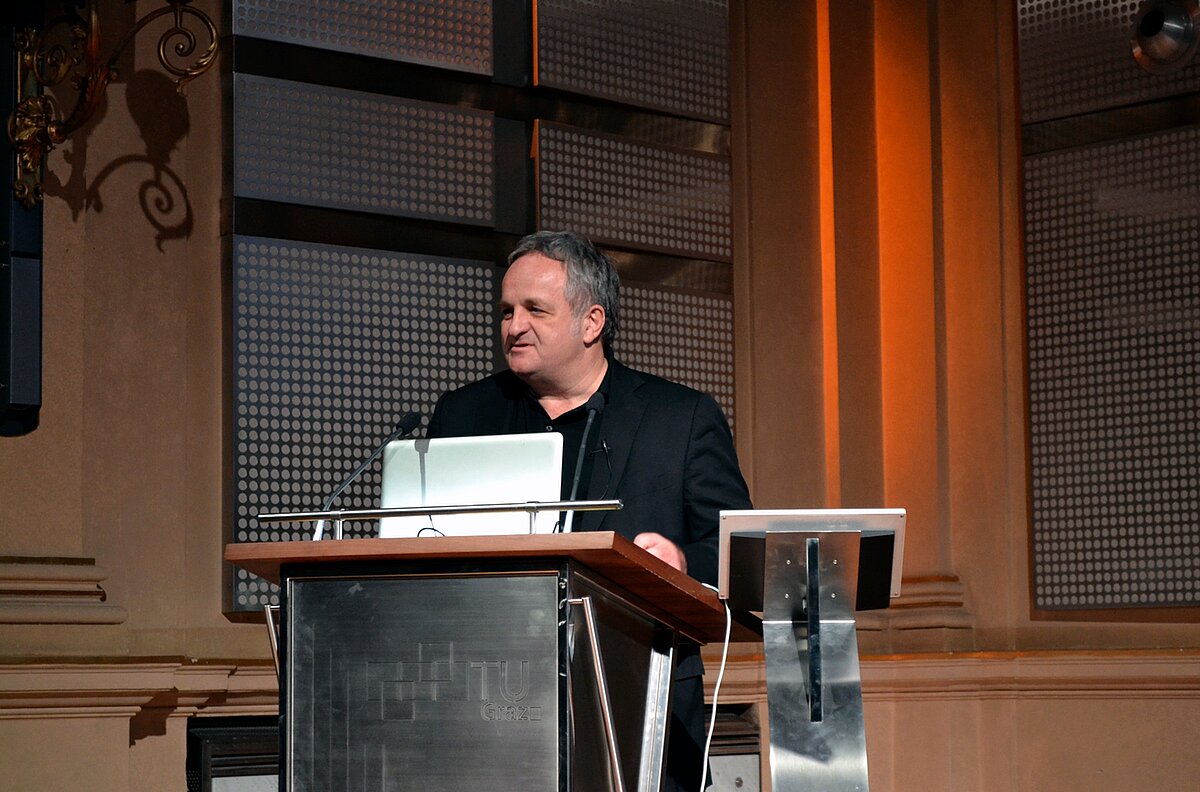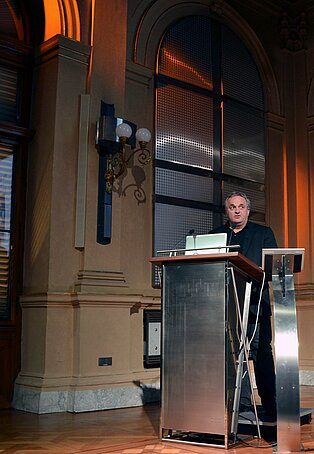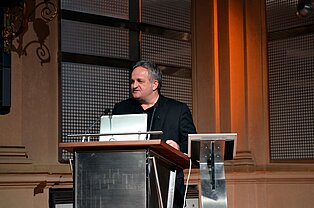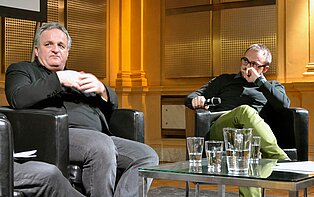Architecture means doing it anyway
Tight budgets, the ersatz religion of “sustainability”, Croatia’s love for the Pope, and the power of the “FAILED” stamp – Saša Randić lets rip with a sweeping blow brimming with humour, self-deprecation, and composure in equal measure. It’s a fitting finale to the Graz November Talks 2014.
Pula, Rovinj, Krk: for Austrians, these picture-postcard places are dream holiday destinations, with their historic centres which look as though someone has planted Graz’s UNESCO roof scape in the middle of the Kvarner Bay. These locations form the backdrop at the start of the lively presentation by Saša Randić, who was born in Rijeka in 1964, at the November Talks at the Graz University of Technology (TU Graz).
According to Randić, Croatia’s architecture had actually experienced permanent booms, up until 2009. And then came the economic crisis, and everything flipped 180 degrees and took a huge step back. Where others use architecture presentations to show off their greatest triumphs, Randić rattles off a series of very different images in quick succession – the “FAILED” stamp adorns almost every one of the projects from the “paper architecture” department – except for those which say “ON HOLD”. Schools, public buildings, residential building projects: nothing but sketches that were never built, because of a lack of money or an “administrative hiccup”. Randic and Associates had high hopes for an “extremely rich” customer, but the bankroller ultimately vanished into thin air. He continues with dry humour: “Besides, we’re getting older and there are fewer of us.” And he strikes out again: “The architectural paradigm is shifting from creating new buildings to renovating old ones.”
The do-it-yourself narrative
According to Randić, Croatia’s history and identity pose another challenge. There are no sword-wielding heroes or identity-defining narratives to provide a point of reference. He takes the audience on a brief journey though the history of Croatia, highlighting the Venetian period, skirmishes with the Ottomans, the Tito era, and finally the powerhouse of the modern day: the EU. “If there are no points of reference, we have to make our own,” he explains. Just like in Nietzsche, who says that God dies and leaves behind a white spot. It may then be that the EU has to intervene and invent an eleventh commandment: “Thou shouldst build sustainably.” As is the case, for example, with the Museum of Modern and Contemporary Art in Rijeka. The plan was to create an additional outer skin made of glass, which would make the building energy-efficient and enclose the existing T-shaped construction. But the money supply dried up – and this “FAILED” project was not to be the only one. The second attempt – as Rijeka is aiming to be named European Capital of Culture for 2020 – also came to nothing.
Angels over Rijeka
Despite the EU and its commandments, God is still strongly linked with the Pope in Croatia, just as the Pope is linked with Croatian independence – the country has hosted the pontiff three times, most recently in June 2003, when John Paul II visited Rijeka. The Franciscan Order commissioned a hall for the pilgrims. Its location is a famous place of pilgrimage: angels are said to have carried the tent of the Holy Family through the air from Nazareth directly to Rijeka in 1291. Randić designed a tabernacle with a “fabric” made of bricks. Invisible forces stretch the fabric in different places and let light in through the gaps. The adjoining portico forms niches in which improvised confessionals wait for the believers on Assumption Day. “The Franciscans are very practical people,” says Randić.
Follow the white rabbit!
Saša Randić also managed to mix business with pleasure in his “Katarina Frankopan” nursery school in Krk (completed in 2006). Situated on a hill between shopping malls and holiday homes, this colourful wonderland covers 2379 m² and consists of interior and exterior areas, niches, narrow alleys, and gardens, just like the historic centre of a small Dalmatian town. The children can pedal through this miniature urban world on their tricycles – there are even parking spaces. There are four units for the very little ones, and seven for the older children. Randić freely admits that, as an architect, you can do whatever you want with a nursery school. No matter how colourful, creative, and crazy the design is, you can justify anything by saying it’s for children. You can even become a child again yourself – with no worries about a lack of money, economic crises, or EU regulations.
Saša Randić was born in Rijeka, Croatia, in 1964. He studied architecture at the University of Zagreb and completed an MA in 1992 at the Berlage Institute in Amsterdam. In 1993, he founded “Randić-Turato Architects” together with Idis Turato. Since 2009, he has been operating under the name of Randic and Associates and currently has 12 employees in Zagreb and Rijeka. He has taught at the Harvard University GSD, ETH Zurich, Berlage Institute Rotterdam, Institute for Advanced Architecture Barcelona, Rotterdam Biennale, TU München (Technical University of Munich), and the Buenos Aires Biennale. He currently teaches at the Split School of Architecture.





